Abstract
1. The dynamic and kinetic interactions of alcohol and caffeine were studied in a double-blind, placebo controlled, cross-over trial. Treatments were administered to eight healthy subjects in four experimental sessions, leaving a 1 week wash-out period between each, as follows: 1) placebo, 2) alcohol (0.8 g kg-1), 3) caffeine (400 mg) and 4) alcohol (0.8 g kg-1) + caffeine (400 mg). 2. Evaluations were performed by means of: 1) objective measures: a) psychomotor performance (critical flicker fusion frequency, simple reaction time and tapping test), b) long latency visual evoked potentials ('pattern reversal'); 2) subjective self-rated scales (visual analogue scales and profile of mood states); 3) caffeine and alcohol plasma concentration determinations. 3. The battery of pharmacodynamic tests was conducted at baseline and at +0.5 h, +1.5 h, +2.5 h, +4 h and +6 h. An analysis of variance was applied to the results, accepting a P < 0.05 as significant. The plasma-time curves for caffeine and alcohol were analysed by means of model-independent methods. 4. Results obtained with caffeine in the objective measures demonstrated a decrease in simple reaction time and an increase in the amplitude of the evoked potentials; the subjects' self-ratings showed a tendency to be more active. Alcohol increased simple reaction time and decreased amplitude of the evoked potentials, although the subjects rated themselves as being active. The combination of alcohol + caffeine showed no significant difference from placebo in the objective tests; nevertheless, the subjective feeling of drunkenness remained. The area under the curve (AUC) for caffeine was significantly higher when administered with alcohol.(ABSTRACT TRUNCATED AT 250 WORDS)
Full text
PDF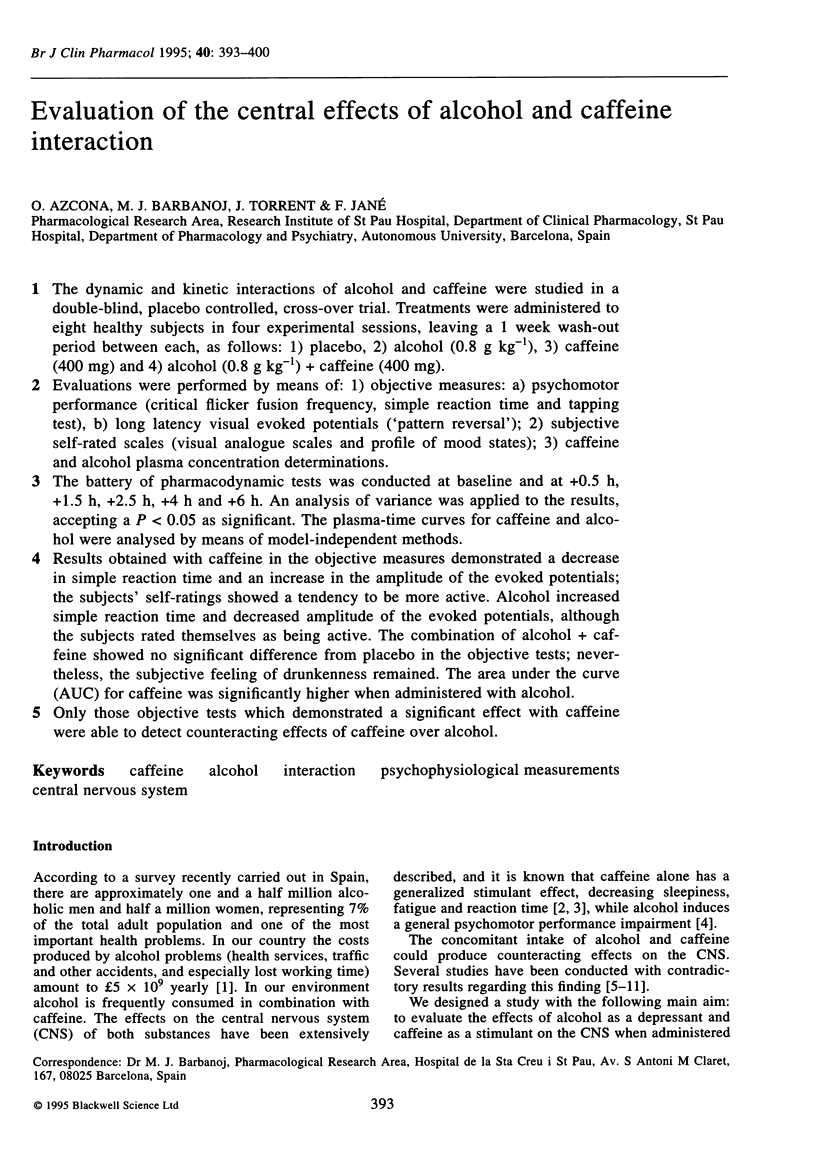
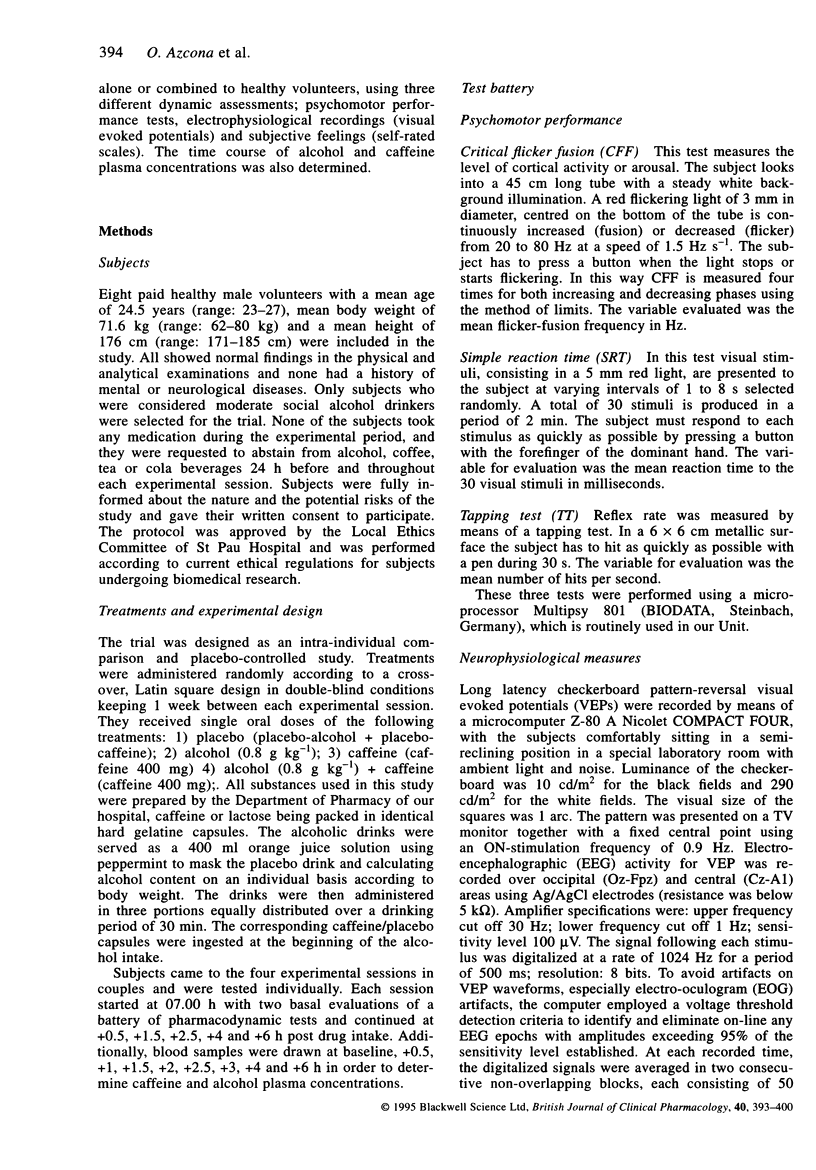
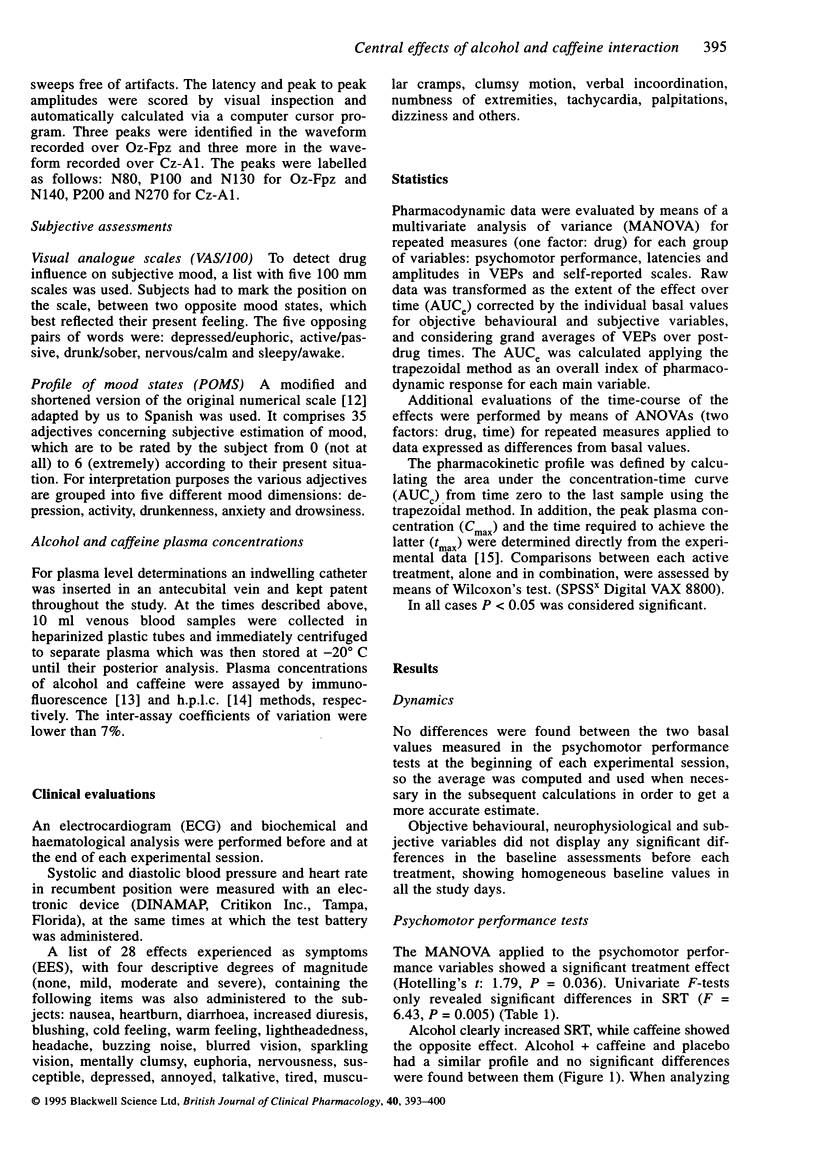
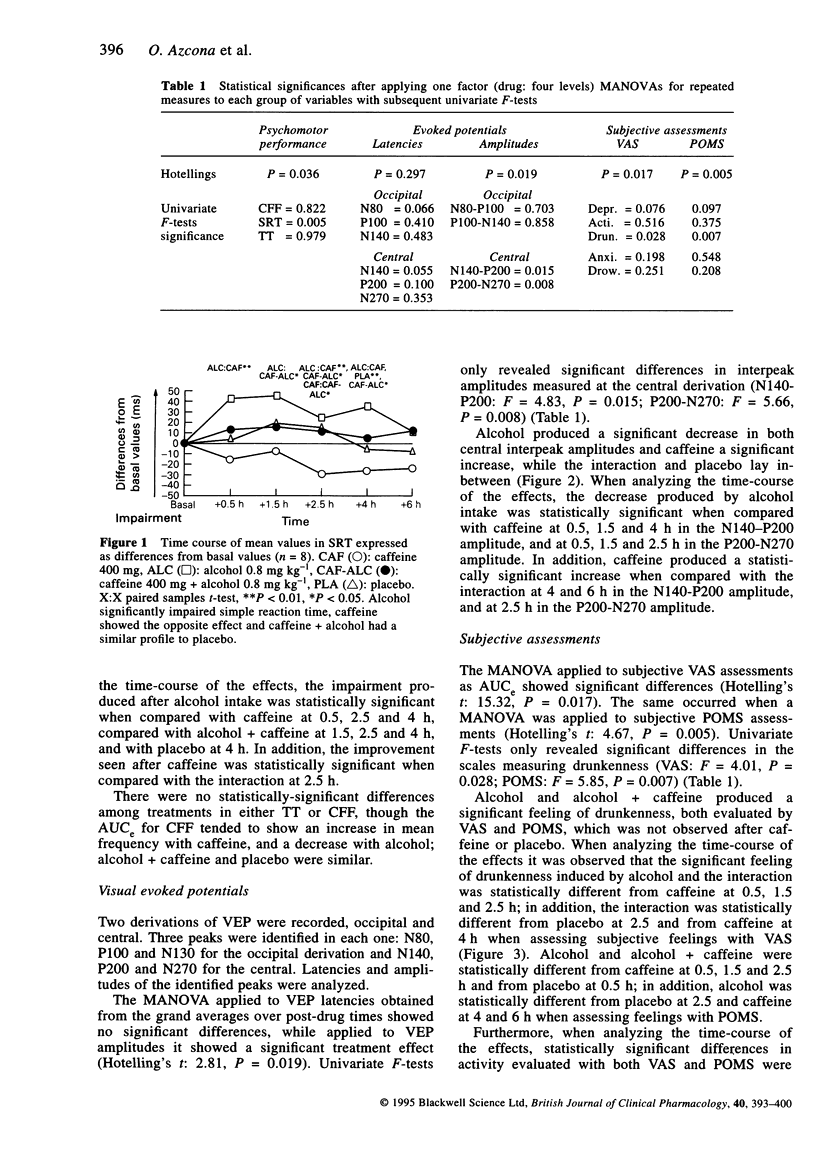
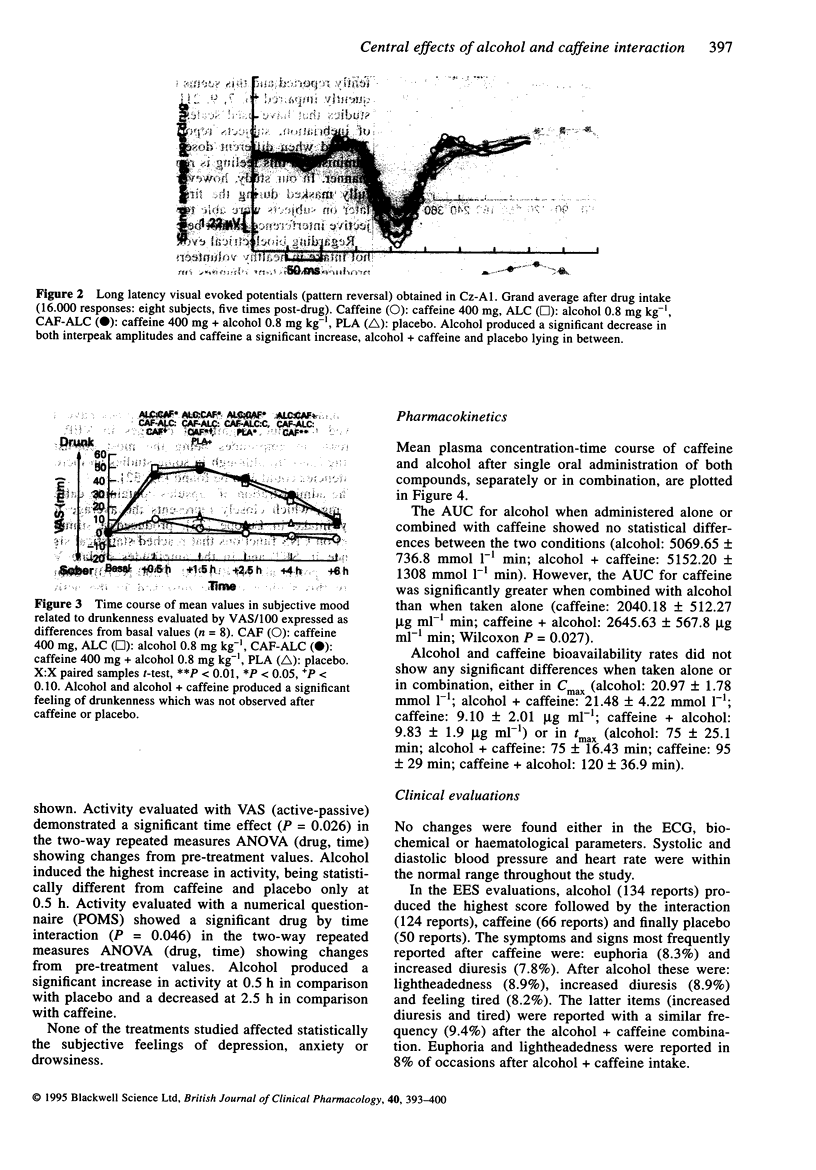
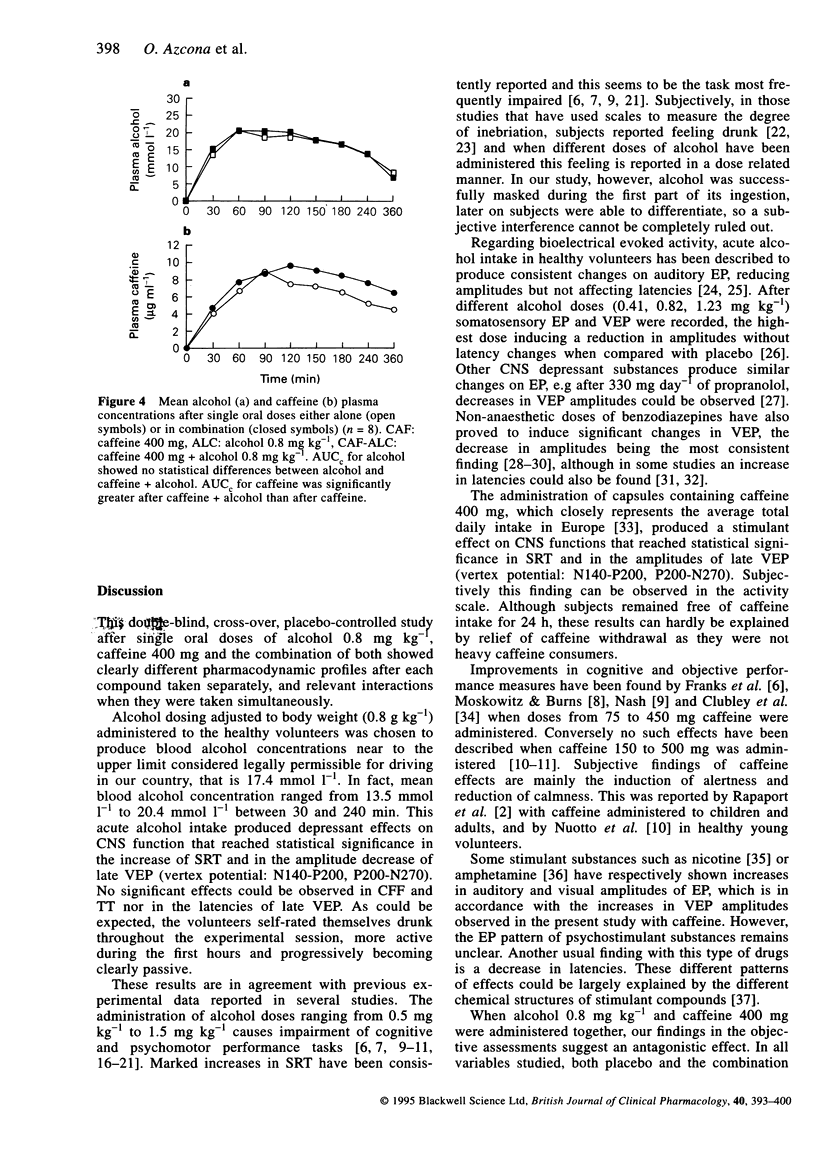
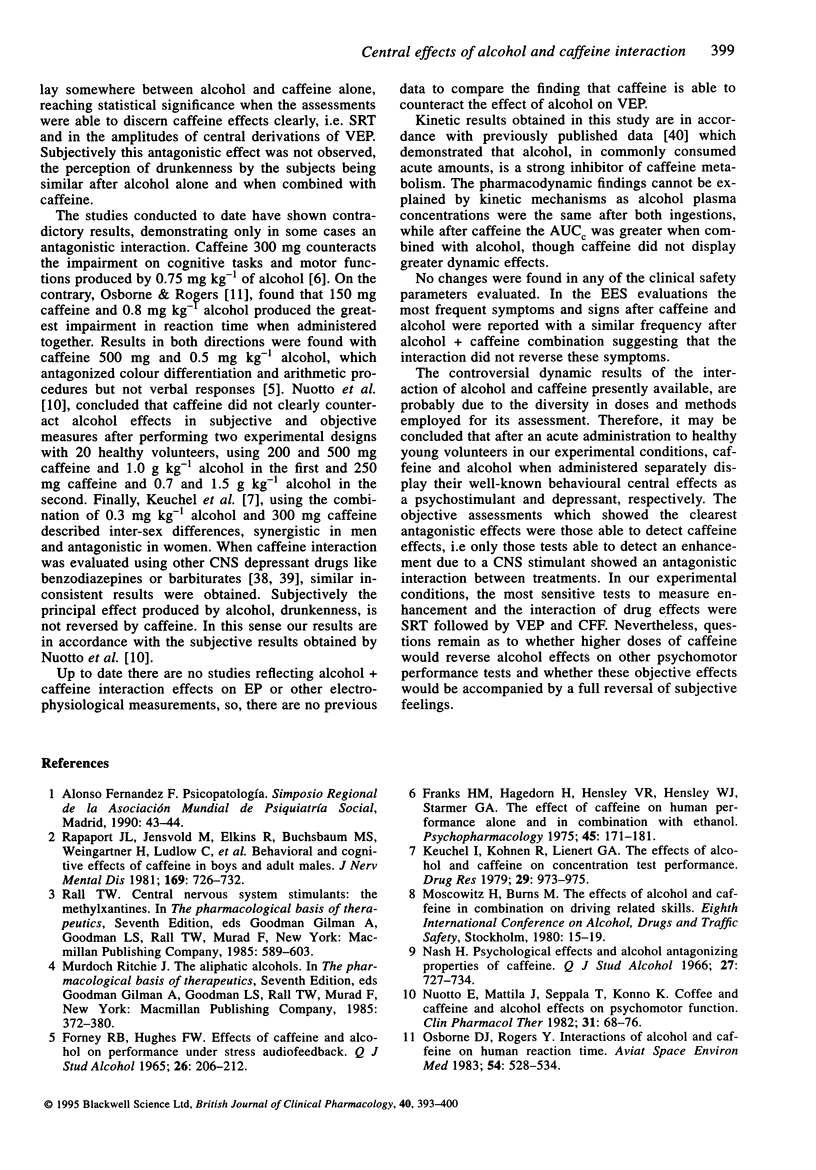
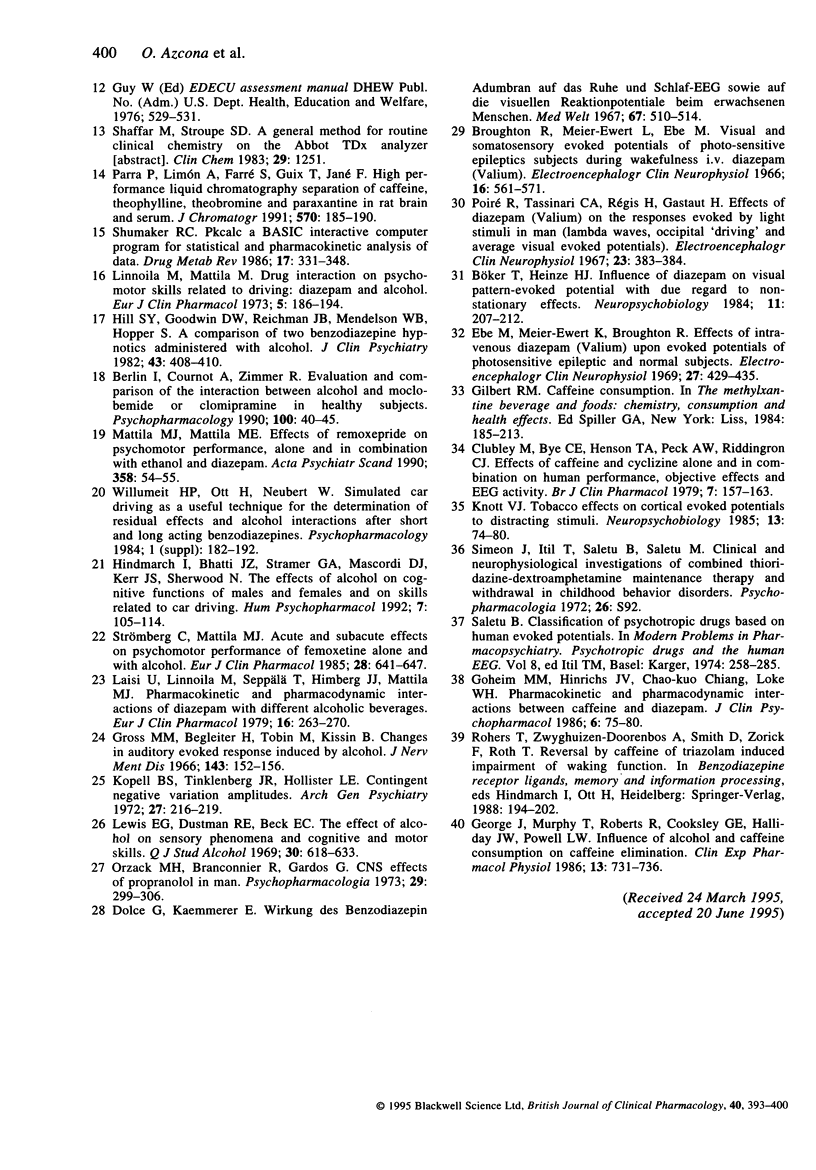
Selected References
These references are in PubMed. This may not be the complete list of references from this article.
- Berlin I., Cournot A., Zimmer R., Pedarriosse A. M., Manfredi R., Molinier P., Puech A. J. Evaluation and comparison of the interaction between alcohol and moclobemide or clomipramine in healthy subjects. Psychopharmacology (Berl) 1990;100(1):40–45. doi: 10.1007/BF02245787. [DOI] [PubMed] [Google Scholar]
- Böker T., Heinze H. J. Influence of diazepam on visual pattern-evoked potentials with due regard to nonstationary effects. Methodological problems. Neuropsychobiology. 1984;11(3):207–212. doi: 10.1159/000118079. [DOI] [PubMed] [Google Scholar]
- Dolce G., Kaemmerer E. Wirkung des Benzodiazepin Adumbran auf das Ruhe- und Schlaf-EEG sowie auf die visuellen Reaktionspotentiale beim erwachsenen Menschen. Med Welt. 1967 Mar 4;9:510–514. [PubMed] [Google Scholar]
- Ebe M., Meier-Ewert K. H., Broughton R. Effects of intravenous diazepam (valium) upon evoked potentials of photosensitive epileptic and normal subjects. Electroencephalogr Clin Neurophysiol. 1969 Oct;27(4):429–435. doi: 10.1016/0013-4694(69)91454-0. [DOI] [PubMed] [Google Scholar]
- FORNEY R. B., HUGHES F. W. EFFECT OF CAFFEINE AND ALCOHOL ON PERFORMANCE UNDER STRESS OF AUDIOFEEDBACK. Q J Stud Alcohol. 1965 Jun;26:206–212. [PubMed] [Google Scholar]
- Franks H. M., Hagedorn H., Hensley V. R., Hensley W. J., Starmer G. A. The effect of caffeine on human performance, alone and in combination with ethanol. Psychopharmacologia. 1975 Dec 31;45(2):177–181. doi: 10.1007/BF00429058. [DOI] [PubMed] [Google Scholar]
- George J., Murphy T., Roberts R., Cooksley W. G., Halliday J. W., Powell L. W. Influence of alcohol and caffeine consumption on caffeine elimination. Clin Exp Pharmacol Physiol. 1986 Oct;13(10):731–736. doi: 10.1111/j.1440-1681.1986.tb02414.x. [DOI] [PubMed] [Google Scholar]
- Ghoneim M. M., Hinrichs J. V., Chiang C. K., Loke W. H. Pharmacokinetic and pharmacodynamic interactions between caffeine and diazepam. J Clin Psychopharmacol. 1986 Apr;6(2):75–80. [PubMed] [Google Scholar]
- Gross M. M., Begleiter H., Tobin M., Kissin B. Changes in auditory evoked response induced by alcohol. J Nerv Ment Dis. 1966 Aug;143(2):152–152. doi: 10.1097/00005053-196608000-00005. [DOI] [PubMed] [Google Scholar]
- Hill S. Y., Goodwin D. W., Reichman J. B., Mendelson W. B., Hopper S. A comparison of two benzodiazepine hypnotics administered with alcohol. J Clin Psychiatry. 1982 Oct;43(10):408–410. [PubMed] [Google Scholar]
- Keuchel I., Kohnen R., Lienert G. A. The effects of alcohol and caffeine on concentration test performance. Arzneimittelforschung. 1979;29(6):973–975. [PubMed] [Google Scholar]
- Knott V. J. Tobacco effects on cortical evoked potentials to distracting stimuli. Neuropsychobiology. 1985;13(1-2):74–80. doi: 10.1159/000118166. [DOI] [PubMed] [Google Scholar]
- Lewis E. G., Dustman R. E., Beck E. C. The effect of alcohol on sensory phenomena and cognitive and motor tasks. Q J Stud Alcohol. 1969 Sep;30(3):618–633. [PubMed] [Google Scholar]
- Mattila M. J., Mattila M. E. Effects of remoxipride on psychomotor performance, alone and in combination with ethanol and diazepam. Acta Psychiatr Scand Suppl. 1990;358:54–55. doi: 10.1111/j.1600-0447.1990.tb05288.x. [DOI] [PubMed] [Google Scholar]
- Nuotto E., Mattila M. J., Seppälä T., Konno K. Coffee and caffeine and alcohol effects on psychomotor function. Clin Pharmacol Ther. 1982 Jan;31(1):68–76. doi: 10.1038/clpt.1982.11. [DOI] [PubMed] [Google Scholar]
- Oborne D. J., Rogers Y. Interactions of alcohol and caffeine on human reaction time. Aviat Space Environ Med. 1983 Jun;54(6):528–534. [PubMed] [Google Scholar]
- Orzack M. H., Branconnier R., Gardos G. CNS effects of propranolol in man. Psychopharmacologia. 1973;29(4):299–306. doi: 10.1007/BF00429277. [DOI] [PubMed] [Google Scholar]
- Parra P., Limon A., Ferre S., Guix T., Jane F. High-performance liquid chromatographic separation of caffeine, theophylline, theobromine and paraxanthine in rat brain and serum. J Chromatogr. 1991 Sep 18;570(1):185–190. doi: 10.1016/0378-4347(91)80214-w. [DOI] [PubMed] [Google Scholar]
- Poiré R., Tassinari C. A., Régis H., Gastaut H. Effects of diazepam (Valium) on the responses evoked by light stimuli in man (lambda waves, occipital "driving" and average visual evoked potentials). Electroencephalogr Clin Neurophysiol. 1967 Oct;23(4):383–384. [PubMed] [Google Scholar]
- Rapoport J. L., Jensvold M., Elkins R., Buchsbaum M. S., Weingartner H., Ludlow C., Zahn T. P., Berg C. J., Neims A. H. Behavioral and cognitive effects of caffeine in boys and adult males. J Nerv Ment Dis. 1981 Nov;169(11):726–732. doi: 10.1097/00005053-198111000-00007. [DOI] [PubMed] [Google Scholar]
- Shumaker R. C. PKCALC: a BASIC interactive computer program for statistical and pharmacokinetic analysis of data. Drug Metab Rev. 1986;17(3-4):331–348. doi: 10.3109/03602538608998295. [DOI] [PubMed] [Google Scholar]
- Strömberg C., Mattila M. J. Acute and subacute effects on psychomotor performance of femoxetine alone and with alcohol. Eur J Clin Pharmacol. 1985;28(6):641–647. doi: 10.1007/BF00607908. [DOI] [PubMed] [Google Scholar]
- Sureda A., Hernández Madrid A., Pérez Vaquero M. A., Pérez de Oteyza J., Escribano L., Odriozola J. Quinidine-induced agranulocytosis of abrupt onset. Acta Haematol. 1990;84(1):43–44. doi: 10.1159/000205026. [DOI] [PubMed] [Google Scholar]
- Willumeit H. P., Ott H., Neubert W. Simulated car driving as a useful technique for the determination of residual effects and alcohol interaction after short- and long-acting benzodiazepines. Psychopharmacology Suppl. 1984;1:182–192. doi: 10.1007/978-3-642-69659-6_16. [DOI] [PubMed] [Google Scholar]


